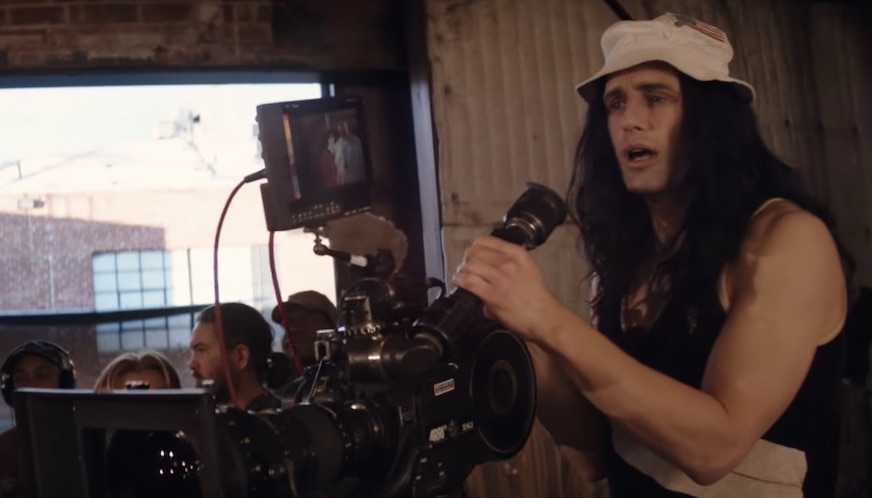The Bad, The Good, and The Difference
For all its amateurishness, “The Room” is authentic, a heartfelt, if inarticulate, expression of a naive artist. “The Disaster Artist” is an artificial substitute. James Franco as Tommy Wiseau in "The Disaster Artist." (A24 / YouTube)
James Franco as Tommy Wiseau in "The Disaster Artist." (A24 / YouTube)
In the annals of turning lemons into lemonade, the movie division, two films are notorious for snatching success from the jaws of failure.
“The Rocky Horror Picture Show” (1975), a gender-bending pastiche of 1930s horror movies, holds championship honors. Pronounced dead on arrival at the box office, it was resurrected as a work of participatory performance art that comically questioned gender binaries. In the process, it became a midnight-movie evergreen, the audience paying tribute to the film’s sexual acceptance and its so-bad-it’s-good-ness.
“The Room” (2003)—a vanity project produced, written by, directed and starring rookie filmmaker Tommy Wiseau—is the contender. Wiseau, resembling a headbanger and sounding as if he learned phonetic English from a vampire movie, spent $6 million on his inept, incoherent and vaguely porny love triangle that prompted many viewers to ask for their money back within its first 30 minutes. The film’s undiluted awfulness, seen by some as comical and by others as an artifact of outsider art, has earned it the distinction of “The ‘Citizen Kane’ of bad movies,” another case of “so bad it’s good.” In any event, it’s one of those movies that should be seen to be disbelieved.
The same cannot be said of “The Disaster Artist,” the new feature film about Wiseau and the making of “The Room.” It is directed by and stars James Franco as Wiseau and co-stars Dave Franco (James’ brother) as Wiseau pal Greg Sestero, who co-starred in “The Room.” (Sestero wrote the book “The Disaster Artist,” a comedy of errors about how he met and befriended Wiseau and what happened on the set while making “The Room.”)
Franco’s film is disappointing and more than a little patronizing. His swanning, hair-tossing impersonation of Wiseau laughs at, rather than with, the first-time filmmaker attempting to make it in Hollywood.
For all its amateurishness, “The Room” is authentic, a heartfelt, if inarticulate, expression of a naïve artist. “The Disaster Artist” is an artificial substitute, the work of a sophisticate who thinks that by replicating outsider art, he can tap into its energy. “The Disaster Artist”—and Franco’s performance as Wiseau—is mimicry. It doesn’t reimagine “The Room.” Nor does it use Wiseau’s film as a springboard to dive into the heart of it, as, say, John Coltrane did when he took Richard Rodgers’ “My Favorite Things” and blew the whiskers off kittens.
My guess is that Franco, a smart guy and ordinarily a deft comic actor, has spent enough time around the industry to see Wiseau and his movie as a metaphor for Hollywood, where narcissism and neediness are rampant and unexamined. In “The Room,” the naked neediness of Wiseau’s screen character, ultimately betrayed by friends and lovers, is painful and unexamined.
Yet in “The Disaster Artist,” both the movie and the movie-within-the-movie, Wiseau’s neediness, tone-deafness and cluelessness are the joke. (That said, I laughed heartily when in his Carpathian accent Franco-as-Wiseau insists that “The word director comes from dictator.”)
Do you need to see “The Room” to understand “The Disaster Artist”? Perhaps. The latter film’s meta references might be funnier. (If you do want to see “The Room,” here’s screening information for Los Angeles.
Is it possible that Franco conceived “The Disaster Artist” as a personal and professional self-justification? It occurred to me this might be the case when Franco’s Wiseau wistfully says to Sestero, frustrated by the disorder on the set, that “The worst day on a movie is better than the best day anywhere else.”
Noted.
If you’re in the market for a funny movie about inept filmmakers whose ambitions exceed their talent, rent or stream Frank Oz’s “Bowfinger,” written by Steve Martin and co-starring Martin and Eddie Murphy.
Your support matters…
Independent journalism is under threat and overshadowed by heavily funded mainstream media.
You can help level the playing field. Become a member.
Your tax-deductible contribution keeps us digging beneath the headlines to give you thought-provoking, investigative reporting and analysis that unearths what's really happening- without compromise.
Give today to support our courageous, independent journalists.






You need to be a supporter to comment.
There are currently no responses to this article.
Be the first to respond.